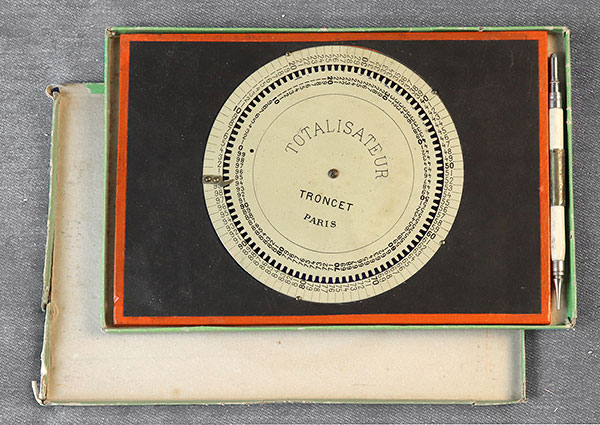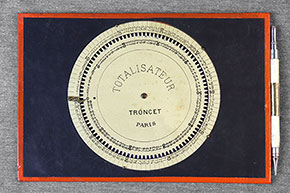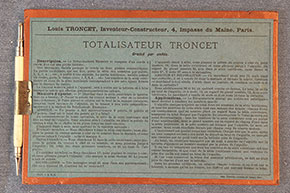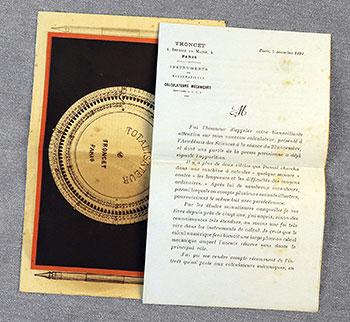 Up
Up
|
|

|

|
Troncet’s OTHER calculator |
|
|
|
|
|
|
Louis-Joseph Troncet (1850-1920) made a name
for himself with his popular “Arithmographe”,
a compact slide adder he patented in 1889. This useful little
calculator was not his own invention – it relies on work by Heinrich
Kummer from 1847 – but Troncet’s version was a market hit, becoming
so popular that for a while all similar devices (and there were a
great many) were known as “Troncets”. Sadly, I don’t have an original Arithmographe in my collection (though I have a number of its clones, like this one). As a consolation, fate sent my way another calculator introduced by Troncet in 1891, which was definitely not a market hit, so it is actually a rare item indeed. Here it is, in the box it came in: |
|
|
|
 Click photo to enlarge |
|
|
|
The Totalisateur in as simple as an adder can
get: a single dial with 100 teeth, numbered 0–99, which can be
rotated by a stylus; and a fixed scale around it, also numbered
0–99. To add numbers you start with the dial set to zero (as read
out at the hook-like stop on the left), then insert the stylus next
to the number you want to add on the outer scale, and rotate
counterclockwise until the stylus hits the stop. Repeat with other
numbers; the accumulated sum appears at the stop. As long as the
result is below 100, you can keep adding one- and two-digit numbers. The device is built on a rigid rectangular plate 17.7x12x0.5 cm in size, which is covered in black paper on its front and a blue instruction sheet on the back. The disk and ring that do the math are made of thin painted sheet metal. The stylus is stored in a clip at the side. |
|
|
|

 Click a photo to enlarge |
|
|
|
Troncet was a good marketer, as evidenced by the success of his other adder; and he made a good effort to market the Totalisateur. It comes, with a neat stylus clipped to it, packaged in a nice cardboard box; and the box contains an instruction sheet and a letter addressed to a prospective client. The letter includes excerpts from reviews in various Parisian newspapers, and offers the device at 1.90 Francs, with quantity discounts going up to 30% when ordered by the gross (a dozen dozens, or 144 units). From the reviews we learn that the device had been presented at the Acedemy of Sciences, another good marketing move. |
|
|
|
From the
instructions it
is clear that the calculator came in two versions, the one I have
which is graduated in units (0,1,2,3,... 99), and one graduated in
fives (0,5,10,15,...495). I’ve also seen online
a version combining the two on the same baseplate. So why was this unit, despite the marketing and the good reviews, not a success? Well, to be honest, it isn’t very useful. Unlike the vaguely similar Webb adder, it has a limited range of only 0–99, and most people could do small sums in that range in their heads or on paper. As the Journal des Débats points out in its review: “Very convenient for those who are weak in calculation” – but then, people who can’t add two small numbers on paper would hardly invest in a calculator. Troncet’s Arithmographe, by contrast, could add 7-digit numbers with results up to millions, which made it a success. |
 Click photo to enlarge |
|
|
|
Exhibit provenance: eBay. More info: A scan of the marketing letter. Biographical information on Troncet. |
|
|
|
|
|
|
|
Home | HOC | Fractals | Miscellany | About | Contact Copyright © 2023 N. Zeldes. All rights reserved. |
|